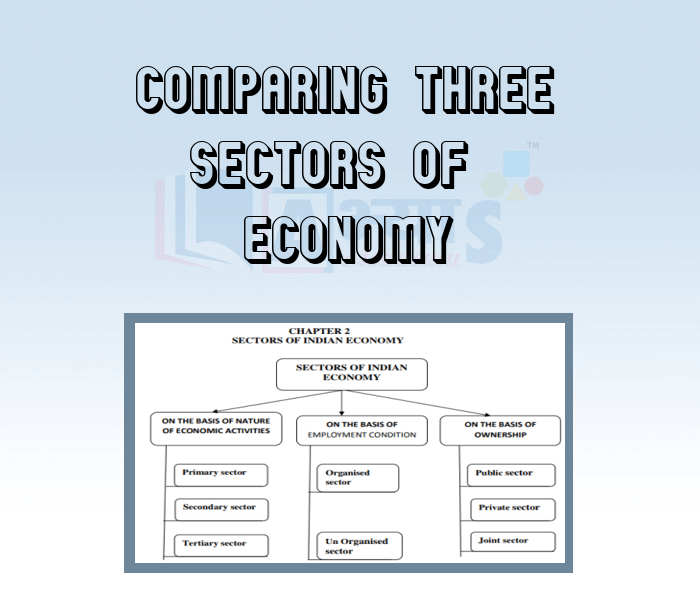Comparing Three Sectors of Economy











Comparing Three Sectors of Economy
Comparing The Three Sectors: Various production activities in the primary, secondary and tertiary sectors produce a very large number of goods and services. Also, the three sectors have a large number of people working in them to produce these goods and services.How do we count the various goods and services and know the total production in each sector?
For example- if 10 000 Kgs of wheat is sold at Rs 8 per kg & the value of wheat will be Rs 80,000. The value of 5000 coconuts at Rs 10 per coconut will be Rs 50,000, Similarly the value of goods and services in the three sectors are calculated and then added up. Remember, there is one precaution one has to take. Not every good (or service) that is produced and sold needs to be counted. It makes sense only to include the final goods and services. Take for instance a farmer who sells wheat to a floor mill for Rs 8 per kg. The mill grind the wheat and sells the flour to a biscuit company for Rs 10 per kg. The biscuit company uses the flour and things such as sugar and oil to make four packets of biscuits. It sells biscuits in the market to the consumer for Rs 60 (Rs15 per packet). Biscuits are the final goods i.e. good that reach the consumer.Why are only final goods and services counted? In contrast to final goods such as wheat and the wheat flour in this example are intermediate goods. Intermediate goods are used up in producing final goods. Intermediate goods are used up in producing final goods and services.
The value of final goods already includes the value of all the intermediate goods that are used in making the final good. Hence, the value of Rs 60 for the biscuits( final good) already includes the value of flour (Rs 10). The value of final goods and services produced in each sector during a particular year provides the total production of the sector for that year. Therefore biscuit is the final goods and its value will only be counted to find the production level . Value of intermediate goods are not counted .
Match List 1 with List 2 | |||||||||||||
| Right Option : A | |||||||||||||
| View Explanation | |||||||||||||
Students / Parents Reviews [10]
It has a great methodology. Students here can get analysis to their test quickly.We can learn easily through PPTs and the testing methods are good. We know that where we have to practice

Barkha Arora
10thIt was good as the experience because as we had come here we had been improved in a such envirnment created here.Extra is taught which is beneficial for future.

Eshan Arora
8thMy experience was very good with Abhyas academy. I am studying here from 6th class and I am satisfied by its results in my life. I improved a lot here ahead of school syllabus.

Ayan Ghosh
8thIt was a good experience with Abhyas Academy. I even faced problems in starting but slowly and steadily overcomed. Especially reasoning classes helped me a lot.

Cheshta
10thAbhyas Methodology is very good. It is based on according to student and each child manages accordingly to its properly. Methodology has improved the abilities of students to shine them in future.

Manish Kumar
10thMy experience with Abhyas academy is very good. I did not think that my every subject coming here will be so strong. The main thing is that the online tests had made me learn here more things.

Hiya Gupta
8thOne of the best institutes to develope a child interest in studies.Provides SST and English knowledge also unlike other institutes. Teachers are co operative and friendly online tests andPPT develope practical knowledge also.

Aman Kumar Shrivastava
10thMy experience with Abhyas is very good. I have learnt many things here like vedic maths and reasoning also. Teachers here first take our doubts and then there are assignments to verify our weak points.

Shivam Rana
7thI have spent a wonderful time in Abhyas academy. It has made my reasoning more apt, English more stronger and Maths an interesting subject for me. It has given me a habbit of self studying

Yatharthi Sharma
10thAbhyas is a complete education Institute. Here extreme care is taken by teacher with the help of regular exam. Extra classes also conducted by the institute, if the student is weak.
